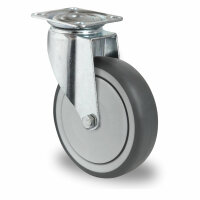Views: 0 Author: Site Editor Publish Time: 2025-07-01 Origin: Site

In high-temperature industrial environments, the performance of equipment components is paramount. One such critical component is the Heavy Duty Rubber Castor. These castors are essential for the smooth and safe movement of heavy machinery and equipment. Understanding how they handle high temperatures can lead to better selection, maintenance, and overall efficiency in industrial operations.
Heavy duty rubber castors are engineered using specialized rubber compounds designed to withstand extreme conditions. The rubber used typically contains additives that enhance heat resistance, such as carbon black and other reinforcing agents. These additives improve the thermal stability of the rubber, allowing it to maintain structural integrity at elevated temperatures.
Moreover, the core of the castor wheel is often made from materials like cast iron or steel, which contribute to the overall load-bearing capacity and thermal conductivity. This combination of a durable core and a heat-resistant rubber tread ensures the castor can perform efficiently in demanding environments.
The ability of rubber castors to handle high temperatures depends largely on the thermal properties of the rubber material. Key properties include:
Heat Resistance: The maximum temperature at which the rubber maintains its physical properties.
Thermal Degradation: The point at which the rubber begins to decompose chemically due to heat.
Thermal Conductivity: The material's ability to conduct heat away from the surface.
High-performance rubbers like silicone and fluorocarbon elastomers are sometimes used for applications requiring exceptional heat resistance. However, for heavy duty castors, specially formulated natural or synthetic rubbers are optimized for both load-bearing and thermal performance.
When designing heavy duty rubber castors for high-temperature environments, engineers must consider several factors:
At elevated temperatures, the mechanical strength of rubber can diminish. To counter this, manufacturers increase the thickness of the rubber or reinforce it with heat-resistant fabrics and fibers. The core material also plays a vital role in maintaining structural integrity under load at high temperatures.
Rubber materials expand when heated. Design must account for thermal expansion to prevent deformation that could impede wheel rotation or cause misalignment. Allowing sufficient clearance and using materials with low thermal expansion coefficients can mitigate these issues.
The bearings used in castors must withstand high temperatures without excessive wear. Metal bearings with high-temperature greases are often selected to maintain smooth operation. Sealed bearings can prevent the ingress of contaminants that could exacerbate wear at high temperatures.
A study conducted in an automotive manufacturing facility assessed the performance of heavy duty rubber castors in a high-temperature paint curing oven. The castors were exposed to temperatures ranging from 100°C to 150°C. Over six months, the castors exhibited minimal wear and maintained structural integrity, demonstrating the effectiveness of heat-resistant rubber compounds.
In another scenario, a foundry utilizing heavy equipment required mobility solutions that could handle temperatures above 200°C. Specialized heavy duty rubber castors with reinforced cores and high-temperature rubber were implemented, resulting in improved equipment maneuverability and reduced downtime due to castor failure.
Proper maintenance is crucial for the longevity of heavy duty rubber castors in high-temperature environments. Recommended practices include:
Regular Inspections: Frequent checks for signs of wear, cracking, or deformation.
Lubrication: Using high-temperature greases for bearings to ensure smooth operation.
Load Management: Ensuring castors are not overloaded, as excessive weight can accelerate degradation at high temperatures.
Environmental Control: Minimizing exposure to contaminants that can affect rubber integrity, such as oils or chemicals.
Ongoing research in polymer science has led to the development of new rubber compounds with enhanced thermal properties. Innovations include:
Incorporating nanoparticles like graphene or carbon nanotubes to improve thermal conductivity and mechanical strength.
Combining rubber with ceramic or metallic fillers to enhance heat resistance without compromising elasticity.
Developing rubbers capable of repairing micro-cracks resulting from thermal stress, thereby extending the service life of the castors.
When selecting heavy duty rubber castors for high-temperature applications, consider the following steps:
Assess the Temperature Range: Identify the maximum and minimum temperatures the castors will be exposed to.
Determine Load Requirements: Calculate the maximum load per castor, including dynamic loads during movement.
Evaluate Environmental Factors: Consider the presence of chemicals, oils, or abrasive materials that could affect castor performance.
Select Appropriate Materials: Choose castors made with rubber compounds and core materials suitable for the identified conditions.
Consult with Manufacturers: Engage with castor specialists to customize solutions if standard products do not meet all requirements.
Heavy duty rubber castors play a critical role in industrial operations where high temperatures are a factor. Understanding the material science behind their construction and the design considerations necessary for high-temperature environments ensures optimal performance and longevity. By selecting the right Heavy Duty Rubber Castor and adhering to proper maintenance practices, industries can enhance efficiency, safety, and cost-effectiveness in their operations.
Heavy duty rubber castors are designed to operate efficiently in temperatures up to approximately 120°C, depending on the specific rubber compound used. For higher temperatures, specialized materials may be required.
High temperatures can reduce the mechanical strength of the rubber, potentially lowering the castor's load capacity. It's important to consult manufacturer specifications for load ratings at elevated temperatures.
Yes, alternatives such as phenolic resin wheels, nylon wheels, or steel wheels may be suitable for higher temperature environments. Each material has its advantages and limitations regarding heat resistance and load capacity.
Exposure to chemicals can affect the integrity of the rubber, especially at high temperatures. It's essential to select rubber compounds that are resistant to specific chemicals present in the environment.
Maintenance frequency depends on usage intensity and environmental conditions. However, in high-temperature applications, more frequent inspections are recommended to catch early signs of wear or degradation.
Signs include cracks on the rubber surface, loss of elasticity, discoloration, and in severe cases, melting or deformation of the rubber material.
Yes, retrofitting is generally possible. It's important to ensure the new castors are compatible with the equipment's mounting configurations and meet the necessary load and temperature specifications.